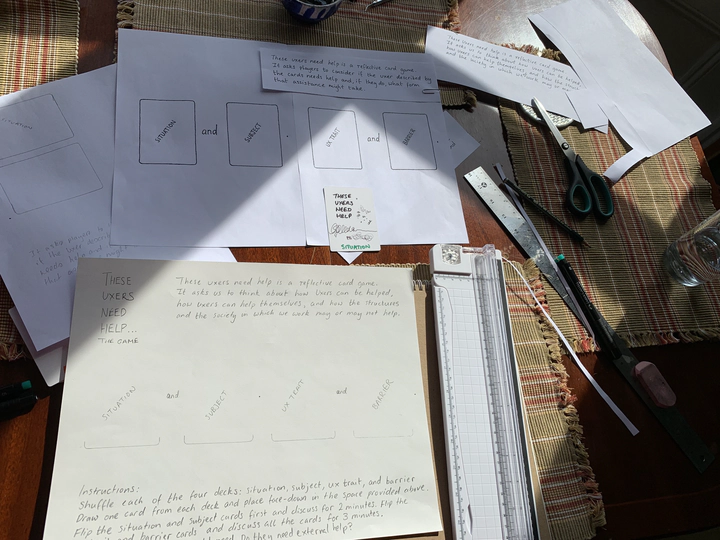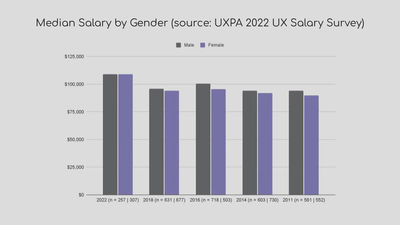UX Camp Brighton 2023 - Game on!
These Uxers need help - The Game
 Prototyping the game board with paper and pencils
Prototyping the game board with paper and pencils
Today is UX Camp Brighton!
It is is 6.30am on the day of UX Camp Brighton 2023, one of my favourite days of the year! It is also the event’s 10th anniversary. I starting attending back in 2014; we go back a long way. Check out UX Camp Brighton’s history page for a flavour - I just noticed that I am on there!
What is UX Camp Brighton?
It is a BarCamp style event where anyone can present on a topic related to UX for 20 minutes. In the morning you are given an index card and you add your presentation title and description and put it up in a grid which indicates which room you will use. You then provide a verbal pitch to convince people to attend. I always try to generate some humour with my titles, last year’s title was: Let’s talk about LX maybe, lets talk about you and me (refer to Salt-N-Peppa’s seminal 1989 album Blacks’ Magic).
Why do I love UX Camp Brighton?
Every year I get to meet such amazing designers including people who are new to design and people who have years or experience. I also have design friends who I only see at this event and every year I catch-up with how they are doing and what they are working on. In short I learn a lot about what is going on in design in a short period of time and I have boatloads of fun doing it.
What do I do at UX Camp Brighton?
Every year I attend I tend to host a session myself. Last year my friend Lou encouraged me to be brave and present in the biggest lexture hall type room. That was great and worked well as it was a slide-based presentation. However, although the session was good upon reflection afterwards I felt like I tried to pack too much in content and theory-wise (for more - check out my post about last year’s event).
What am I doing instead this year?
Many of my presentations are strangely inspired by short conversations with one of the UX Camp Brighton organisers Luke Hay, this year is no different. Luke said “why don’t you do something about Ladies that UX Brighton?”. I thought about this and also ruminated on what I had heard a couple of times when I first started to volunteer for Ladies that UX (LTUX). Some folks had queried, and to note there is never anything wrong with a bit of constructive enquiry, why groups like LTUX are still needed? This is a valid point given that LTUX was founded in 2013 in Manchester, when speaking from experience as a woman or non-male person you’d find yourself looking around the room at tech conferences to find the two handfuls of people who were also not male. Representation for women in UX is far more healthy - a recent survey by Zippia estimating that in the United States 40.4% of UX designers are women and 59.6% are men. The 2022 UXPA survey as analysed by MeasuringU also points towards the fact that salary equality is on the rise in UX, with women earning slightly more than men in the 5 to 7 year experience bracket (data is United States-centric as only 9% of responses are from the UK).

However…
We need to be careful with this as history tells us that when work get associated with people who are not male, the pay goes down. To provide a quick example, take the pay differential between people working in customer service-related IT versus those in more technical roles (e.g., development, desktop systems). Even when men are in customer service roles this work is fem-coded and is usually paid less. I am just planting the seed of this idea in this post for now as I hope we can have a discussion panel on this in future at LTUX Brighton. In the meantime check out these fantastic resources which have been educating me on the subject.
-
The work of Mar Hicks, specifically her book Programmed Inequality: How Britain Discarded Women Technologists and Lost Its Edge In Computing.
-
Daley Wilhelm’s recent article on Medium, Why are women encouraged to go into UX?.
-
Talks given by Saielle DaSilva, as quoted by Matt LeMay at UX Brighton.
Get to the point Fiona…
This year I have designed a game to playtest. The game encourages reflection on power and social capital in UX. Some people enter UX with more power automatically, some with less. How can we help within the community to not only level the playing field but start the race from the same starter mark on ‘said’ field? The game is losely inspired by Cards Against Humanity, but has a four deck structure.
The cards create two sentences which describe a fictional UXer. The friction created between the two sentences and the concepts within them is designed to stimulate conversation. The game probes the fascade of being a designer and is about helping us to empathise with struggles which are internal and external to a person.
-
Deck 1: Situation - this is how much power you bring to this situation. This could be a positive, neutral or negative value. For example, positive could be you know influential people, negative would be that you grew up in a poor family.
-
Deck 2: Subject - this is ‘subject’ as in subjectivity of a UXer . Again this could be a positive, neutral or negative. So neutral could be “is a boxset binger” and negative could be, “is a solutioniser”.
-
Deck 3: UX Trait - this is thing that they do in UX. However, it is all not all kittens and puppies, sometimes they aren’t happy in their field or are unsure of what to do next.
-
Deck 4: Barrier - this is something that is preventing them from being the best they can be. For example, they “don’t have a portfolio”, or “have very little money”.
That’s all for now, but I want to take a moment to cite my inspirations for the game.
-
For more on power dynamics and UX check this month’s LTUX UX Book Club book, Beyond Sticky Notes: Co-design for Real: Mindsets, methods and movements by Kelly Ann McKercher (if you would like to come to book club on Weds 26th April, you can sign-up on Eventbrite).
-
Jeff Sauro, How to Assess Brand Affinity & Sentiment
-
Anthony Dunne and Fiona Raby’s speculative design practice.
-
Ruben Pater, The Politics of Design
-
The blank poker cards I bought and then hand drew to create this game!